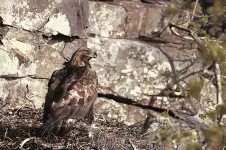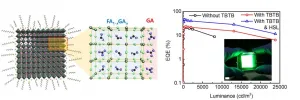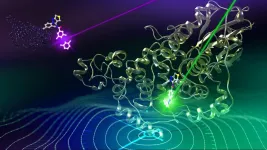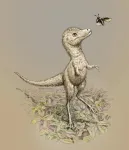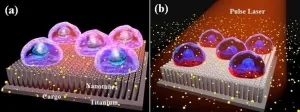(Press-News.org) Scientists have shown where bird species would exist in the absence of human activity under research that could provide a new approach to setting conservation priorities.
A study by Durham University, UK, in collaboration with the Royal Society for the Protection of Birds (RSPB), investigated how human activities such as agriculture, deforestation, and the drainage of wetlands have shaped where bird species are found in Great Britain today.
Researchers used data on the geographical distributions of bird species alongside simulation models to predict where bird species would exist today if the effects of human activities on the landscape were removed.
In this scenario there were winners and losers among different bird species due to the impact of humans.
The study found that 42 per cent of the 183 breeding bird species considered were more widely distributed today than they would be in a human-free world, particularly birds associated with farmland habitats.
Conversely, 28 per cent of species, particularly moorland and upland bird species, were much rarer today than they would be if they were not impacted by human activities.
The researchers say their findings, published in the journal Ecological Indicators, could apply to other parts of the world, too.
Co-lead author of the study, Dr Tom Mason, previously of Durham University's Department of Biosciences, but now based at the Swiss Ornithological Institute, said: "Our study suggests that farmland bird species, such as Turtle Dove and Grey Partridge, would be less widespread without the open habitats created by agriculture while moorland species, such as Golden Eagle and Greenshank, have probably been negatively affected by the long-term, extractive human use of moorlands by grazing, burning, hunting and forestry.
"We also found that species found in dense woodlands, such as Goshawk and Capercaillie, would be much more widespread in a 'human-free' Great Britain, which would be much more forested than the present day."
The study produced human-free range-size estimates which were compared against current bird distributions.
Conservation managers often use target population sizes, based on past distributions, to guide species' recovery programmes. The impact of conservation activities can then be assessed by comparing current numbers to historical numbers of bird species.
The authors argue that their approach, which instead uses simulated potential range-sizes as baselines, could complement indicators of short-term extinction risk such as the IUCN Red List of Threatened Species.
Professor Stephen Willis, of Durham University's Department of Biosciences, co-lead author on the study, said: "Our results could lead to reassessments of current conservation priorities. We identified 21 species that were not classified as threatened by the IUCN Red List for Great Britain but which had much smaller current distributions than we predict them to have in the absence of human activities.
"This suggests that their ranges are in a more degraded state than currently recognised. Some of these species, such as Greenshank, Golden Eagle and Whinchat, are not under active conservation management and could be candidates for higher prioritisation."
The researchers say that considering only recent changes in species' state can lead to a phenomenon known as "shifting baseline syndrome", where people set their expectations based on experiences in their lifetime.
This can underestimate the plight of species that have declined due to human activities a long time ago. Previous studies have tried to combat this by using historical baselines from past centuries, however historic species' records tend to be sparse and are difficult to apply across different species.
The study also identified 10 species that are not currently found in Great Britain, but which might have established themselves in the country in the absence of past human activities.
For example, the researchers say that the Kentish Plover, which has not bred in Great Britain since the middle of the 20th century, was projected to be found across south-east England in the absence of damaging human activity.
Similarly, the White-tailed Eagle, which currently has a small presence, and the Black-winged Stilt, which is a very rare breeder in Great Britain, would also be expected to be much more widespread than they are now.
The authors believe that their approach could be used to identify areas that are climatically suitable, but where habitat may have been degraded by human activities.
The RSPB plans to use this new research as one of a number of measures of how 'favourable' breeding bird populations are in Great Britain as it provides an objective measure against which to assess species' ranges or distributions.
This is important as it helps the RSPB to quantify Favourable Conservation Status and standardise methodology for its assessment. Favourable Conservation Status is an important political standard set for the conservation of migratory species under the Bonn Convention, and for habitats and species protected by EU Nature Directives.
Study co-author Dr Gillian Gilbert, of the RSPB, said: "This work could help to target where habitat and species restoration actions might lead to the return of historically lost species, or even to novel colonists."
The authors are now planning to extend their approach to also evaluate species' population sizes, which they hope will lead to lead to unified population targets for species across Great Britain.
INFORMATION:
The research was funded by the RSPB.
Public health researchers, led by UNSW Sydney, have estimated the number of cancer cases requiring surgery globally each year, predicting the number will rise from 9.1 million to 13.8 million from 2018 to 2040 - an increase of 52 per cent or 4.7 million cases.
Their research shows the greatest relative increase will occur in 34 low-income countries, where the number of cases requiring surgery is expected to more than double by 2040 (314,355 cases to 650,164, or 107 per cent).
The modelling study, published in The Lancet Oncology on Friday, analysed global demand for cancer surgery and estimated surgical and anaesthesia ...
Research team at Seoul National University (Prof. Tae-Woo Lee) and University of Pennsylvania (Prof. Andrew M. Rappe) developed perovskite light-emitting diodes (PeLEDs) with an external quantum efficiency (EQE) of 23.4%. The research results were published in Nature Photonics, which is the world-renowned international academic journal, on January 4th (Title: Comprehensive defect suppression in perovskite nanocrystals for high-efficiency light-emitting diodes).
Metal halide perovskites have very narrow spectral emission, excellent color purity, low material cost, and wide and easy color-tunability. ...
The Nagoya University Institute of Transformative Bio-Molecules (WPI-ITbM) research team of Designated Associate Professor Tsuyoshi Hirota, Postdoctoral Fellow Simon Miller, Professor Kenichiro Itami and graduate student Tsuyoshi Oshima (Research Fellowship for Young Scientists, JSPS), in collaboration with the group of Professor Ben Feringa and Postdoctoral Fellow Dušan Kolarski of Groningen University in the Netherlands, have achieved a world first: fully reversible manipulation of the period of the circadian clock using light, by exchanging part of a compound with a light-activated switch.
Waking in the ...
Greater sports participation among Aboriginal and Torres Strait Islander children is linked with better academic performance, according to new research from the University of South Australia.
Conducted in partnership with the University of Sydney and the University of Technology Sydney, the world-first study found that Aboriginal and Torres Strait Islander children who played organised sports every year over four years, had numeracy skills which were advanced by seven months, compared to children who did less sport.
The study used data from four successive waves of Australia's Longitudinal Study of Indigenous Children, following 303 students (with a baseline age of five to six years old) to assess cumulative sports participation against ...
A world-first discovery by researchers at Monash University and The University of Queensland could lead to faster and more effective treatments for chronic health complications, such as cardiovascular disease and cancer, with 'fluorescent' in vivo biosensors.
The research team, led by Dr Simon Corrie from Monash University's Department of Chemical Engineering and the ARC Centre of Excellence in Convergent Bio-Nano Science and Technology, took an antibody that binds EGFR (epidermal growth factor receptor) proteins and engineered it to monitor the concentration of EGFR proteins in serum solutions over time.
Co-authors of the paper, published in ACS Sensors, are Dr Christian Fercher, Dr Martina ...
They are among the largest predators ever to walk the Earth, but experts have discovered that some baby tyrannosaurs were only the size of a Border Collie dog when they took their first steps.
The first-known fossils of tyrannosaur embryos have shed light on the early development of the colossal animals, which could grow to 40 feet in length and weigh eight tonnes.
A team of palaeontologists, led by a University of Edinburgh researcher, made the discovery by examining the fossilised remains of a tiny jaw bone and claw unearthed in Canada and the US.
Producing 3D scans of the delicate fragments revealed that they belonged to baby tyrannosaurs ...
Scientists from UNSW Sydney have developed a ceramic-based ink that may allow surgeons in the future to 3D-print bone parts complete with living cells that could be used to repair damaged bone tissue.
Using a 3D-printer that deploys a special ink made up of calcium phosphate, the scientists developed a new technique, known as ceramic omnidirectional bioprinting in cell-suspensions (COBICS), enabling them to print bone-like structures that harden in a matter of minutes when placed in water.
While the idea of 3D-printing bone-mimicking structures is not new, this is the first time such material can be created at room temperature - complete with living cells ...
The carbon footprint of plastic production for initial use is greater than the global warming impact of the entire process used for medical device reprocessing Use of reprocessed devices is environmentally superior to use of original products in 13 of 16 categories evaluatedReprocessing found to advance "circular economy," a key strategy for reaching the UN Sustainability GoalsLCA offers evidence showing that in order to reduce greenhouse gas emissions and honor the Paris Climate Agreement, EU Member States must opt-in to EU Medical Device Regulation (MDR)'s reprocessing/remanufacturing provisions
[Berlin / Washington, ...
Large-scale production of vegetables and fruit in Spain with intensive plastic consumption in its greenhouse industry is believed to have leaked microplastic contaminants since the 1970s into the surrounding Mediterranean seagrass beds. This is shown in a new study where researchers have succeeded in tracing plastic pollution since the 1930s and 1940s by analyzing seagrass sediments.
About half of Sweden's cucumbers and a fifth of the tomatoes in Sweden are currently imported from Spain according to the Swedish Board of Agriculture. A special area in Spain where large-scale vegetable cultivation ...
Overview:
A research team at the Department of Mechanical Engineering at Toyohashi University of Technology developed a nanosecond pulse laser-assisted photoporation method using titanium-oxide nanotubes (TNTs) for highly efficient and low-cost intracellular delivery. The proof of concept for the possibility of intracellular delivery after irradiation with nanosecond pulse laser on TNTs was validated. TNTs were formed on titanium sheets using the electrochemical anodization technique at different voltages and times. HeLa - human cervical cancer cells were cultured in the nanotubes and submerged in a solution of biomolecules. After cells were exposed to nanosecond pulse laser, we successfully delivered ...
